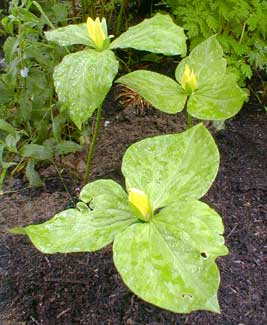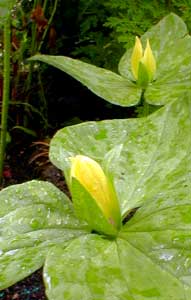
Golden Goblet Trillium; aka:
Yellow Wake-robin, or
Yellow Whippoorwill
"I have touched the trillium,
Pale flower of the land."
-Helen Dudley,
circa 1915
circa 1915
Trillium luteum (aka T. cuneatum var luteum aka T. viride var luteum) is a yellow-flowering version of the common toadshade, with flowers either green or maroon. The Yellow Wakerobbin is native to the American southeast, found in Georgia, Alabama, Kentucky, North Carolina, & Tennessee.
The three yellow petals stand upright in the midst of three green sepals that can either lay flat or be partially upright like the petals. The upright petals lend it the folkname "goblet trillium." The flower has a cistrusy scent. The three large leaves are mottled.
 I spotted this trillium in a nursery mislabeled Trillium sessile. It is "sessile" only insofar as the word means that the flower is stemless, growing immediately upon the center of the three large leaves. But it is definitely not the species. It seems to be a nearly universal error of the nursery trade to sell the large T. cuneteum with the name of the dwarf T. sessile affixed, but this was the only time I found it actually to be the rarer T. luteum, so it was a terribly lucky find.
I spotted this trillium in a nursery mislabeled Trillium sessile. It is "sessile" only insofar as the word means that the flower is stemless, growing immediately upon the center of the three large leaves. But it is definitely not the species. It seems to be a nearly universal error of the nursery trade to sell the large T. cuneteum with the name of the dwarf T. sessile affixed, but this was the only time I found it actually to be the rarer T. luteum, so it was a terribly lucky find.It blooms in April & May. It is a smallish subtle flower at the center of three large leaves, yet even with such subtlty it is much showier than the regular species, which is green-flowered.
As with other trilliums, this will die back at May's end or very early in summer if allowed to dry out, but if kept moist in a shady location the leaves will last until autumn, then return the following spring as a larger clump than would have been the case had it been permitted to die back in summer.
It is difficult to propogate, & so greatlly dislikes being transplanted that there is a good chance of it dying if it is stolen from the wild. So even if you live somewhere where you spot them growing, don't molest them, as it is worth paying the extra it costs for properly nursery-grown specimens which will be quick to establish in the garden. It wants partial to full shade & regular moisture in humousy soil, under which conditions it thrives very easily, though it should not be disturbed once established.
Like other stemless toadshades it can be slow to establish. But protected from droughtiness, too much sun, & disruption, it will in time become a splendidly showy clump of flowers lighting up a shady moist location